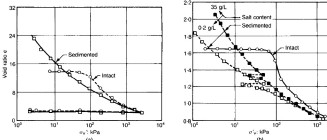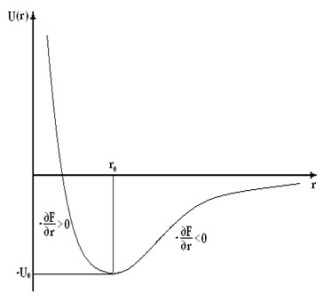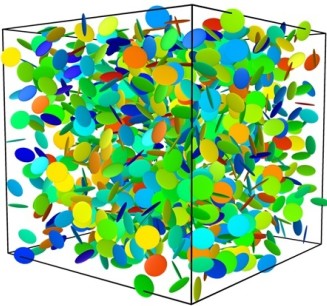Sara Bandera
FUNDAMENTAL ANALYSIS OF THE INFLUENCE OF STRUCTURE ON CLAY BEHAVIOUR
Started: October 2017
Supervisors: Prof. Catherine O’Sullivan, Dr. Stefano Angioletti-Uberti, Dr. Paul Tangney
Funding: The Leverhulme Trust
Clay is the most abundant type of soil on the Earth’s surface. According to the British Geological Survey (2016), clay minerals constitute an estimated 16% of the total volume of soil. Unlike cohesionless materials, clay is challenging to study because the influence of structure (i.e. fabric and inter-particle forces) on its behaviour cannot be neglected. Several classifications of fundamental clay fabrics, derived mainly from SEM images, are given in the literature (Sides and Barden, 1970; Collins and McGown, 1974). The particular fabric observed depends on the characteristics of the depositional environment of clay, such as pore fluid chemistry and strength of inter-particle forces.

As noted by Atkinson (2007), the basic framework used to describe clay behaviour was developed by considering destructured, reconstituted samples of clay, where no bonds are present between particles. By contrast, most natural soils have some structure and bonding. Experimental evidence of structure effects has been shown (Figure 1) by several authors (e.g. Burland, 1990; Leroueil and Vaughan, 1990; Cotecchia and Chandler, 1997, 2000) by comparing the behaviour of natural (with structure) and equivalent reconstituted (without structure) clays.
This research aims to improve the understanding of the response of clay to applied loads and

deformations by explicitly simulating the interactions between clay particles. The focus is on improving the understanding of the effects of structure.
Particle-scale simulations of clay are much less common than Discrete Element Method (DEM) simulations of sand because the elementary units and the inter-unit interactions are difficult to characterise. Consequently, conventional DEM modelling cannot be used. However, an alternative modelling technique called Molecular Dynamics (MD) can be used. MD is a technique mainly used in chemistry, biochemistry and material science to explicitly simulate the motion of atoms or coarser-grained particles. In MD simulations the interactions between particles are described by using a pairwise potential (Figure 2), function of the position of the particles. Pairwise interactions typically consist of long-range electrostatic attraction or repulsion, long-range Van der Waals attraction and a short-range repulsion to prevent the interpenetration of matter.
The viability of using particle-based simulation to study clay has been demonstrated in a small number of recent studies. Ebrahimi et al. (2014 and 2016) used atomistic-level MD simulations to calibrate the parameters of the Gay Berne potential for meso-scale Wyoming Na-montmorillonite platelets (Figure 3). Sjoblom (2016) modelled kaolinite by approximating each clay particle as a hexagonal platelet made up of spheres using a force field different from Gay-Berne potential. Other contributions include 2D papers by Anandarajah et al. (2003, 2013).

OBJECTIVES
• Develop algorithms to control the fabric of the virtual clay samples in MD simulations.
• Reproduce overall clay behaviour, including known effects of structure on clay, using particle-scale simulations
REFERENCES
• Anandarajah, A. & Amarasinghe, P. M.., 2013. Discrete-element study of the swelling behaviour of Na-montmorillonite. Géotechnique, 63(8), pp.674-681
• Atkinson, J., 2007. The Mechanics of Soils and Foundations Second, Taylor and Francis
• Burland, J.B., 1990. On the compressibility and shear strength of natural clays. Géotechnique, 40(3), pp.329-378
• Collins, K. & McGown A., 1974. The form and function of microfabric features in a variety of natural soils. Géotechnique, 24, pp.223-254
• Cotecchia, F. & Chandler, R.J., 2000. A general framework for the mechanical behaviour of clays. Géotechnique, 50(4), pp.431-447
• Cotecchia, F. & Chandler, R.J., 1997. The influence of structure on the pre-failure behaviour of a natural clay. Géotechnique, 47(3), pp.523-544
• Ebrahimi, D., Pellenq, R.J.-M. & Whittle, A.J., 2016. Mesoscale simulation of clay aggregate formation and mechanical properties. Granular matter, 18(3), pp.1-8
• Ebrahimi, D., Whittle, A.J. & Pellenq, R.J.-M., 2014. Mesoscale properties of clay aggregates from potential of mean force representation of interactions between nanoplatelets. The Journal of Chemical Physics, 140, p.154309
• Ebrahimi, D., Pellenq, R.J.-M. & Whittle, A.J., 2012. Nanoscale elastic properties of montmorillonite upon water adsorption. Langmuir, 28, pp.16855-16863
• Israelachvili, J.N., 2011. Intermolecular and Surface Forces Third., Elsevier
• Leroueil, S. & Vaughan, P.R., 1990. The general and congruent effects of structure in natural soils and weak rocks. Géotechnique, 40(3), pp.467-488
• Sides, G. & Barden, L., 1971. The microstructure of dispersed and flocculated samples of kaolinite, illite and montmorillonite. Canadian Geotechnical Journal, 8(3), pp.391-399
• Sjoblom, K. J., 2016. Coarse-Grained Molecular Dynamics Approach to Simulating Clay Behavior. Journal of Geotechnical and Geoenvironmental Engineering, 142(2), p.6015013
• Yao, M. & Anandarajah, A., 2003. Three-Dimensional Discrete Element Method of Analysis of Clays. Journal of Engineering Mechanics, 129(6), pp.585-596


